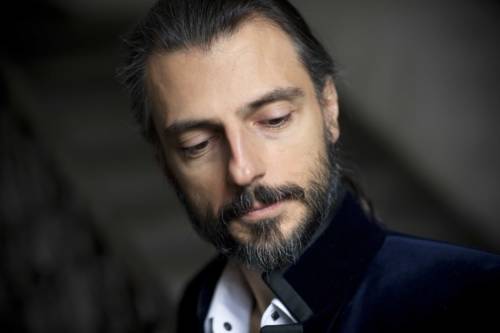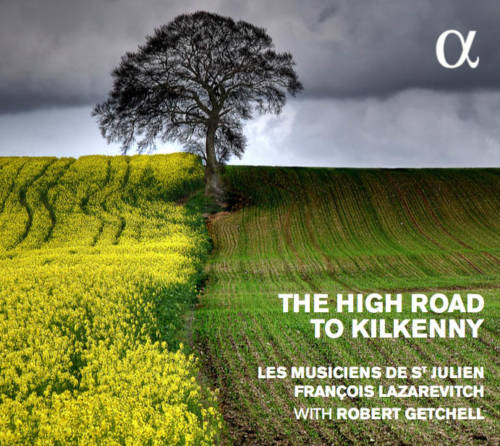Telemann, 12 Fantaisies
Tracklisting

 Diapason 5
Diapason 5 Choc Classica
Choc Classica
Alpha Classics • Alpha 267 • ISBN 3760014192678 • 1 CD • 0 h 58
- Fantasia 1 in A major (3:22)
- Fantasia 2 in a minor (5:10)
- Fantasia 3 in b minor (4:08)
- Fantasia 4 in Bb major (4:10)
- Fantasia 5 in C major (4:29)
- Fantasia 6 in d minor (6:21)
- Fantasia 7 in D major (5:58)
- Fantasia 8 in e minor (4:36)
- Fantasia 9 in E major (6:19)
- Fantasia 10 in f# minor (4:50)
- Fantasia 11 in G major (3:57)
- Fantasia 12 in g minor (5:29)
Listen to the disc
About

Programme
Georg Philipp Telemann
Telemann’s 12 Fantasies are a pinnacle of the flute repertoire. Organized by tones gradually rising from the tone of A to that of SOL, a cycle for solo flute of this size has no equivalent. Each having their own climate, these fantasies are miniatures which link together 3 or 4 movements of the same tone. They have in common the conciseness, the brevity of the forms and the rapid alternation of their movements. At every moment Telemann keeps the listener in suspense by playing on the effects of contrast and surprise through the alternation of opposite characters and tempi.
Interpreter
François Lazarevitch: transverse flute
François Lazarevitch signs again a record that accesses at first place in the discography.
Philippe Venturini – classica
Press
may 2017
Classica – choc
Philippe Venturini
François Lazarevitch lets a free and strong breath flow through the work of the prolific Baroque
Telemann submitted to the constraints of fantasy four times, each time for a single instrument: the transverse flute, the violin, the keyboard and the viola da gamba. The object of these compositions, like so many others at the time (we of course think of Bach), is as much to instruct as to entertain. Through its open form, fantasy is most favorable to the exercises of the imagination and the cohabitation of varied styles. Like his contemporaries. Telemann practiced ”Reunited Tastes” dear to Couperin. From the toccata to the dance suite through contrapuntal pages, the music benefits from the diversity of tempos and the variety of the number of movements. We note that ”Fantasy No. 7” would open a possible second part with a French style opening like Bach’s ”Variation No. 16 of the Goldbergs”.
After a magnificent double CD devoted to Bach’s flute music (Alpha, Choc, Classica n°162), François Lazarevitch once again signs a recording which reaches first place in the discography hitherto dominated by Barthold Kuijken (Accent, 1978). ) and Jed Wentz (Brilliant, 2006). If the publisher says nothing about the origin of the instrument (a copy of Rottenburgh?), we appreciate its ample and warm sound, carefully reproduced by Aline Blondiau’s microphones. This fullness of tone, however, never slows down the mobility of the lines and the clarity of the sound planes. Just listen to the precision with which the bass line is suggested (“Fantaisie n°6”). But, despite this precise implementation, the measuring bar must give way to imagination, to eloquence (the rubato in the slow introduction to the ”Fantaisie n°2”, the play of silences in ”No. 4”), to spontaneity (the breaks in tone of ”No. 5”) and to mischief (the concluding jig of ”No. 1”). François Lazarevitch has clearly grasped the polysemy of the word fantasy.
may 2017
Diapason
Jean-Luc Macia
These ”Twelve Fantasies” are not easy to play, requiring the illusion of an imaginary polyphony and a series of brief cells where sonata movements and archetypal dances follow one another. François Lazarevitch first benefits from an instrument of delicate beauty, undoubtedly a baroque wooden traverse (but this is not specified in the CD instructions), with dense colors, with an extra “fat” which benefits the flavor of the timbre without impairing the diction. Lazarevitch, whose art as a “storyteller” is based as much on the practice of the baroque repertoire as on that of so-called popular music, nourishes the voluptuous line with carefully managed pauses and dynamic effects, without the slightest stiffness. The shutters of these twelve kaleidoscopes (from the 1720s) follow one another with rare naturalness. Some examples: the airy phrasing in an ”Allegro” from Fantasy No. 5 to 3′, the atmospheric languor in the middle of No. 9, the serene volubility of ”alla” Bach which opens No. 11 and finally the twirling conclusion with panache of the ultimate Fantasy. Bold silences punctuate certain pages with a sense of drama that one does not expect in such condensed formats. We also note the quality of articulations with studied flexibility – Lazarevitch relies on the writings of Quantz to warn against effective but too schematic articulations. The care that the flautist instills in his interpretation fleetingly attenuates the fanciful character of the scores which do not always have the shimmer that Barthold Kuijken once lent them (Accent, Diapason d’or). But in recent versions, only Héloïse Gaillard aroused as much interest, using several instruments.
april 2017
ResMusica
Stéphane Reecht
Let’s savor Telemann’s Fantasies with François Lazarevitch
The flautist and leader of the Musiciens de Saint-Julien offers us a solo escapade in the fantasies for solo flute of Georg Philipp Telemann, to the warm sound of his traverso. All things considered, Telemann’s twelve Fantasies are the equivalent for the flute of Bach’s six Violin Sonatas and Partitas and six Cello Suites: a coherent cycle of pieces divided into movements, unique in its quality, calling on the best of the musicality and virtuosity of the performer. This is not accompanied but must reflect a harmony and even a counterpoint very present in the score. For this, the flautist’s best allies are generous acoustics and controlled tempi. For the first, François Lazarevitch takes full advantage of the reverberation specific to religious architecture, which makes it easier to suggest polyphony.
For the latter, he adopts a moderation which allows him to take advantage of each movement and its characters, to vary the phrasing and the articulation, to emphasize the numerous finesse of writing and the complexity of certain melodies, and to propose ornaments often spectacular but always on point. In a word, François Lazarevitch gives himself the means to do justice to the title of these pieces, and he succeeds admirably in rendering their fantasy, synonymous here less with lightness than with richness of writing. His very analytical approach, which leads him to see dance rhythms or fugues in many of the movements, means that some are taken really slowly (the Vivace de la Fantaisie 3, or the Dolce de la Fantaisie 6: 3 minutes 45 seconds for six lines of music with covers!). But the acoustics and the richness of the sound mean that the music still holds up. And when the writing demands it, François Lazarevitch achieves the velocity which allows the illusion of several simultaneous voices to be given (Presto from Fantasy 5, first arpeggiated Allegro from Fantasy 11). Telemann’s Fantasies for flute, mostly recorded on the recorder, find in François Lazarevitch a most recommendable traverso interpreter, who rises to the height of Barthold Kuijken and his historic version at Accent.
april 2017
Libre.be
MDM
Thirty-four years after Bartold Kuijken’s historic recording (in every sense of the word), here is a new opportunity to marvel at the irresistible charm of these Telemann Fantasias. Intended “senza basso” and composed around 1720, these pieces are comparable to Bach’s sonatas for solo violin, of which they share the abundant character, inscribed in a learned counterpoint. Everything goes: singing, dancing, popular tunes, approached according to the “united tastes” in vogue at the time. And if Kuijken’s approach favors rhetoric, even drama, Lazarevitch’s is distinguished above all by its poetic climate, its freedom and, of course, its inexhaustible “fantasy”. All inscribed in natural, amply breathed tempos (which does not exclude liveliness) and luminous and colorful sounds.






